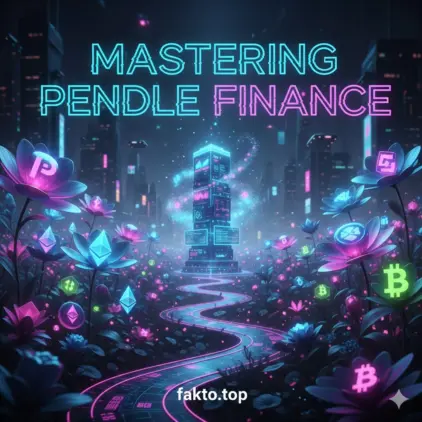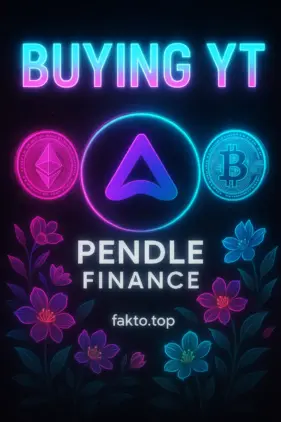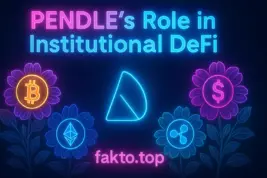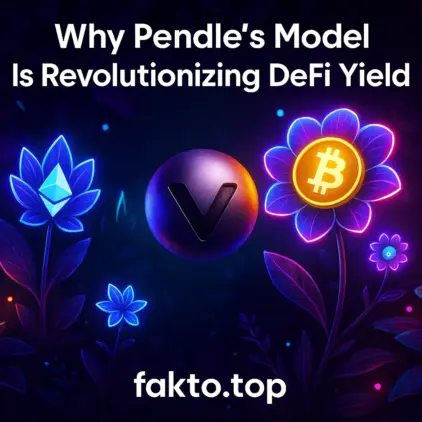Pendle Finance Fixed Yield Strategy: Principal Tokens (PT) Explained
Mastering Pendle Finance: Fixed Yield Strategies and PT/YT Tokenization Explained
In the DeFi wildlands, volatility is both a blessing and a curse. Yields fluctuate, protocols compete for liquidity, and investors juggle risk and reward like circus performers on a tightrope made of code. Somewhere between the chaos of variable APYs and the dream of predictable income stands Pendle Finance — a protocol that doesn’t just generate yield, it tokenizes it. Think of it as DeFi’s version of turning time itself into a tradable asset.
Pendle’s central innovation lies in separating an income-bearing asset into two pieces: the Principal Token (PT) and the Yield Token (YT). This split lets you trade, fix, or speculate on future yield in ways that weren’t possible before. You can hedge against rate drops, lock in guaranteed income, or bet aggressively on the future of DeFi yields — all on-chain, all transparent.

To truly understand Pendle, imagine taking your favorite staking token — say, stETH from Lido — and freezing its future yield into something you can hold, sell, or trade. That’s yield tokenization in action. Pendle turns passive waiting into an active strategy. It gives DeFi participants a choice that traditional markets have enjoyed for decades through instruments like bonds, swaps, and futures — but now, rebuilt in a decentralized environment.
Pendle Finance Yield Tokenization Explained: The Core Concept
Let’s start with the problem Pendle solves. In traditional DeFi, when you stake an asset — for instance, ETH or a stablecoin in a lending protocol — your yield is tied directly to the underlying performance. The only way to capture that yield is to hold the position until maturity. You’re locked in, both in capital and opportunity. Pendle asked a simple but radical question: what if you could separate the yield from the asset and trade it?
That’s the birth of yield tokenization. Pendle allows users to deposit yield-bearing assets into its smart contracts, which then issue two tokens:
- Principal Token (PT): Represents the underlying principal — your original deposit. It can be redeemed for the full amount of the underlying asset when the position matures.
- Yield Token (YT): Represents the rights to future yield generated by the underlying asset until maturity. Think of it as a claim on all future interest — the “harvest rights” of DeFi.
Here’s the trick: once you split your position into PT and YT, each part can be traded independently. If you’re a conservative investor who wants predictable returns, you might sell the YT (the variable yield) and hold the PT, effectively locking in a fixed rate — similar to buying a bond at a discount and redeeming it at full value later. If you’re more speculative, you might do the opposite: buy YT and bet that yields will climb. Either way, Pendle creates a marketplace where future income is priced in real time.
What makes this powerful is that Pendle’s design introduces liquidity and optionality into what used to be static positions. Traditional yield-bearing tokens were like sealed boxes: you knew they were accruing value, but you couldn’t touch that value until the end. Pendle opens those boxes, letting the market decide what that future yield is worth today. This isn’t just financial engineering for fun — it’s a new way to manage risk, express market views, and optimize capital efficiency.
At its core, Pendle Finance is a DeFi derivatives protocol that transforms passive yield into an active marketplace. Its architecture sits comfortably at the intersection of Liquid Staking Derivatives (LSD) and Automated Market Makers (AMMs), making it one of the foundational pillars of what many call the “LSD-Fi” ecosystem — where staking, yield, and composability merge into new forms of on-chain finance.

In the next section, we’ll peel back the technical layers and explore how these two tokens — PT and YT — actually work in practice, how they behave over time, and why understanding their maturity date and implied yield APY is key to mastering Pendle’s system.
3. Core Strategies: How to Use Pendle Finance for Yield Farming
Understanding how to use Pendle Finance for yield farming is where theory meets the real world of DeFi strategy. Pendle is not just another farm-and-dump protocol. It’s a sandbox for managing yield exposure the way traders manage interest rates in traditional markets — with precision, leverage, and intent. Let’s explore three real-world-style scenarios that illustrate Pendle’s potential in action.
The “Crypto Bond” Investor (Buying PT)
Goal: Secure a fixed, guaranteed return while minimizing volatility risk.
Think of buying a Principal Token (PT) as purchasing a zero-coupon bond in the crypto world. When you buy PT, you’re locking in a fixed yield upfront. For instance, if Pendle’s current implied APY for stETH is 6.5%, you can buy PT-stETH that matures in six months. That yield is yours — locked, guaranteed. Even if the actual yield on stETH drops to 4% next month, your return doesn’t change. You’ve effectively bought yield insurance.
Scenario: Alice, a risk-averse DeFi investor, allocates 20% of her ETH portfolio into PT-stETH tokens. She values stability — knowing she’ll earn a predictable 6.5% yield over six months. In return, she gives up the chance to profit if yields spike, but she also avoids panic if yields collapse. Alice is the classic “crypto bondholder” — steady, deliberate, and shielded from DeFi’s chaos.
This approach makes PT ideal for DAO treasuries, conservative yield funds, or anyone building a balanced portfolio that mixes stable returns with higher-risk strategies elsewhere. PTs can even serve as collateral in structured yield vaults, a growing trend among institutional DeFi desks.
The “Yield Trader” (Buying YT)
Goal: Capture leveraged exposure to rising yields without committing full principal capital.
If PTs are crypto’s bonds, then Yield Tokens (YT) are their mirror-image — instruments for speculating on yield direction. When you buy YT, you’re essentially betting that the yield from the underlying asset (say stETH, Aave, or GLP) will outperform its current implied rate. It’s like entering an interest rate swap in traditional finance — you’re paying a small upfront cost for the right to potentially big future returns.
Scenario: Bob, a seasoned DeFi trader, predicts that stablecoin borrowing on Aave will surge next quarter as new protocols integrate Aave markets. He buys YT-AAVE tokens expiring in three months. If yields indeed rise, his YT position increases in value — sometimes exponentially — because YT captures all future yield generated by the underlying tokens. But if rates fall, his YT could lose value. This asymmetric payoff makes YT perfect for directional yield bets.
What’s fascinating is that YT buyers like Bob effectively take the opposite side of PT holders like Alice. The market’s balance between these two camps determines the implied APY — the DeFi version of an interest rate curve. Pendle’s markets are where these invisible forces meet, price, and trade.
The “Market Maker” (Providing LP)
Goal: Earn trading fees and boosted $PENDLE$ rewards by facilitating $PT$ and $YT$ liquidity, acting as a decentralized market maker.

Now meet Charlie — the liquidity provider (LP). He’s the backbone of Pendle, not content with simple yield exposure; he chooses to be the essential middleman, profiting from volume and volatility.
On Pendle, LPs supply capital to pools like PT-stETH/stETH, enabling seamless swaps between the principal token ($PT$) and the underlying asset. This liquidity is crucial for both Alice (the fixed-yield buyer) and Bob (the yield speculator) to execute their trades with minimal slippage.
The Custom-Built AMM Edge
Pendle doesn’t use a standard Automated Market Maker (AMM). It employs a custom-built AMM specifically designed to handle time-decaying assets. This is a non-trivial piece of financial engineering. The formula accounts for the asset’s maturity date, dynamically adjusting the pricing curve to reflect the inevitable convergence of $PT$’s price to the underlying asset’s price over time. This sophisticated design ensures the market remains efficient and capital-efficient, even as the tokens expire.
Scenario
Charlie provides liquidity to the PT-stETH/stETH pool. Each time a trade occurs, Charlie earns trading fees. However, his income is dramatically boosted by the vePENDLE staking mechanism. By locking his $PENDLE$ tokens for a set period, Charlie gains vePENDLE power, which amplifies his rewards from the pool. This creates a powerful liquidity flywheel: long-term commitment directly translates into higher APY and deeper, more robust liquidity for the entire protocol.
In this sense, Pendle LPs are true professional market makers. They don’t gamble on direction like the $YT$ speculators; instead, they profit from the necessary activity between the two camps, turning market volatility and volume into predictable fee income. It’s a highly sophisticated play rewarding deep understanding, patience, and capital efficiency.
PT vs YT: A Side-by-Side Comparison of Pendle’s Yield Components
| Criteria | Principal Token (PT) |
Yield Token (YT) |
|---|---|---|
| Core Goal | Securing Fixed APY / Locking in Interest Rate | Speculating on Floating Yield / Leveraged Exposure |
| Risk Profile | Low (Yield is fixed). Subject only to smart contract risk and underlying asset price risk. | High (Highly volatile, betting on rate increases). Subject to time decay (value drops to zero at maturity). |
| Return Profile | Guaranteed fixed return upon maturity (similar to a zero-coupon bond). | High potential return if floating APY rises significantly; high risk of loss if APY drops. |
| Time Decay | Value increases toward the full value of the underlying asset at maturity. | Value trends to zero as the asset’s maturity date approaches. |
| Ideal User | Conservative investor, risk-averse, hedger, DAO treasuries. | Active trader, high-risk tolerance, bullish on interest rates. |
4. Why Pendle’s Model Is Revolutionizing DeFi Yield
Pendle’s innovation lies in its separation of yield from principal — something even traditional finance hasn’t executed in such an open, programmable way. It transforms passive yield farming into an active marketplace for yield trading. Traders can now hedge, speculate, or synthesize returns that fit precise risk appetites.
This flexibility has drawn both retail investors seeking efficiency and institutions looking for structured yield products. By decomposing yield into tradable tokens, Pendle effectively introduces yield derivatives to DeFi — a concept that’s as fundamental to financial evolution as the introduction of futures and options in traditional markets.
Each trade on Pendle, whether PT or YT, contributes to price discovery of future yields — turning the protocol into a transparent DeFi yield curve. That’s not a buzzword — it’s the infrastructure for pricing risk across an entire ecosystem. It’s how decentralized finance grows up.
Next, we’ll dive into Pendle’s governance layer, tokenomics, and long-term sustainability — where $PENDLE isn’t just a reward token, but the backbone of an evolving yield economy.
5. Governance, Tokenomics & The Power of vePENDLE
Every sustainable DeFi protocol eventually faces the same question: Who controls the levers? Pendle’s answer is elegant and economic — vePENDLE. It’s not just governance; it’s a power structure built around commitment, participation, and alignment between long-term believers and short-term speculators.
The Mechanics of vePENDLE
PENDLE holders can lock their tokens for up to two years to receive vePENDLE (vote-escrowed PENDLE). The longer the lock, the higher the voting power and reward boost. In essence, vePENDLE converts passive holders into active governors — the longer you’re in, the louder your voice becomes.
This system mirrors what Curve pioneered with veCRV, but Pendle takes it further. Here, vePENDLE holders control the flow of liquidity incentives across different yield markets. Every week, vePENDLE votes decide which pools receive new emissions. It’s DeFi’s version of fiscal policy — decentralized, transparent, and brutally competitive.

Imagine Alice, Bob, and Charlie from our earlier scenarios again. Alice locks her PENDLE because she values stable, boosted yields from her PT positions. Bob, who speculates on YT, bribes vePENDLE holders to vote for the Aave pool where his tokens live, hoping to amplify its liquidity and profitability. Charlie, the LP, locks his tokens to maximize his fee boosts. The ecosystem thrives because everyone’s incentives — even when competing — create organic yield depth.
The Bribing Game and Governance Wars
Once vePENDLE voting began to influence emissions, a new meta-game emerged: bribes. Protocols and DAOs began rewarding vePENDLE holders for directing votes their way. It’s not corruption — it’s coordination through incentives. Similar to Curve Wars, Pendle’s ecosystem is now seeing “Yield Wars” where DAOs compete for yield dominance.
This has two major effects. First, it drives demand for PENDLE itself, as protocols must buy and lock it to influence vote outcomes. Second, it fosters deeper liquidity — the pools that receive more emissions attract more volume, creating a self-reinforcing liquidity loop.
In simple terms, vePENDLE turns holders into power brokers. They’re not passive investors — they’re active players in a constantly evolving economic game that determines the future of DeFi yield infrastructure.
Supply Dynamics and Sustainability
The tokenomics of Pendle are structured with long-term sustainability in mind. The total supply of PENDLE is capped at 258 million tokens, with emissions decreasing over time. This ensures that rewards don’t inflate endlessly — a common death spiral in earlier yield protocols. Emission reductions create scarcity, and vePENDLE locks amplify it by removing a portion of the supply from circulation.
Meanwhile, the protocol earns revenue through trading fees in its AMM pools. A portion of these fees is directed to vePENDLE holders, creating a natural flywheel of value accrual. The more the protocol is used, the more fees are generated, the higher the rewards for vePENDLE lockers — a direct alignment of usage and ownership.

PENDLE’s Role in Institutional DeFi
Pendle is increasingly being adopted by DAOs, yield funds, and treasury managers who need to stabilize or enhance returns. The introduction of vePENDLE adds another layer — governance control that’s attractive for organizations managing hundreds of millions in DeFi exposure. By holding vePENDLE, a DAO can effectively steer liquidity incentives toward its preferred assets, giving them leverage over the yield markets themselves.
That dynamic makes PENDLE more than just a utility token — it’s a strategic asset. In a yield-centric ecosystem, influence over yield distribution is economic power. It’s no surprise that vePENDLE accumulation has become a quiet arms race among DeFi-native funds.
6. Pendle’s Place in the Broader DeFi Landscape
Pendle isn’t just a niche tool for advanced users — it’s part of a broader trend reshaping how DeFi approaches yield, risk, and liquidity. Traditional yield farming was reactive: deposit and hope. Pendle introduces a new phase: yield engineering — where participants can design exposure profiles that fit their strategies like a tailor-made suit.
Consider the broader implications. With Pendle, DeFi finally gains a transparent, market-driven yield curve. This unlocks a foundation for more sophisticated products: structured vaults, yield-backed derivatives, and even decentralized fixed-income instruments. As institutions continue to explore on-chain finance, Pendle provides the primitives they need to price, trade, and hedge yield like professionals.
The platform also aligns with the shift toward modular DeFi — where each protocol specializes in a specific financial function. Pendle doesn’t try to be a DEX, a lending platform, or a stablecoin issuer. It’s the yield layer, and that focus is why it thrives. Protocols like EigenLayer, Aave, and Lido now coexist with Pendle as liquidity sources and underlying yield streams — the connective tissue of DeFi’s new economy.
As the crypto market matures, volatility will decline, and yield will become the defining metric of value. In that future, Pendle is not just relevant — it’s foundational. It transforms yield from a background mechanic into a core tradable asset class.
The Future Outlook
Pendle is still young, but its design philosophy is ahead of its time. By separating yield from principal, introducing time-decaying AMMs, and embedding governance incentives into the core of its economy, it sets the stage for an entirely new class of financial instruments. Its continued success will depend on liquidity depth, cross-chain expansion, and integration with institutional DeFi frameworks — all of which are actively underway.
In the end, Pendle Finance represents the maturation of decentralized finance. It’s not just about chasing yield anymore — it’s about understanding, shaping, and owning it. The players who master Pendle’s tools won’t just farm yield; they’ll engineer it, hedge it, and trade it like pros.
As Pendle continues to expand into new markets and assets, it stands to become the benchmark for on-chain yield pricing — the invisible infrastructure beneath the next generation of DeFi strategies.
Conclusion
Pendle Finance has carved out a niche that bridges the simplicity of yield farming and the sophistication of traditional fixed-income trading. It empowers users to move beyond “deposit and pray” strategies, letting them act as traders, hedgers, or liquidity engineers. Through its dual-token model, custom AMM, and vePENDLE governance, it has turned yield — once a passive byproduct — into an active market.
In DeFi’s noisy landscape, Pendle offers clarity: a way to quantify, trade, and control the most fundamental element of crypto economics — yield. Whether you’re Alice the conservative investor, Bob the opportunistic trader, or Charlie the liquidity provider, Pendle gives you the tools to play your game — and win it on your terms.
Pendle’s Unique Value Proposition vs. Traditional DeFi
| Feature | Pendle Finance (PT/YT) |
Standard Liquid Staking (e.g., stETH) | Standard Lending (e.g., Aave) |
|---|---|---|---|
| Yield Fixed Rate | YES (The ability to fix yield is the core offering) | NO (Yield is always variable) | NO (Yield is always variable) |
| Yield Trading | YES (YT is a tradable yield derivative) |
NO (Yield is bundled with the principal) | NO |
| Leverage on Yield | YES (Buying YT provides leveraged exposure to the underlying APY) |
NO | NO (Leverage is on capital, not on the rate of return itself) |
| Required Knowledge | High (Requires understanding PT, YT, and the custom AMM) |
Low/Medium | Medium (Requires collateral management and health factor) |
| DeFi Analogy | Interest Rate Swaps / Zero-Coupon Bonds | Savings Account / Treasury Bills | Secured Loan / Margin Trading |
Risks and Final Considerations for Pendle Users
Final Verdict
While Pendle Finance unlocks remarkable flexibility in yield management, it is not without risk. The separation of yield into PT and YT introduces complexity — understanding the time decay of YT, the redemption schedule of PT, and AMM mechanics is crucial. Smart contract vulnerabilities, market volatility, and impermanent loss for LPs are real considerations. Users must approach positions thoughtfully, balancing ambition with caution.
Important: It’s vital to remember that while the PT secures a fixed yield, both PT and YT holders remain exposed to the price volatility of the underlying asset (e.g., stETH). Fixed yield doesn’t mean fixed capital. Even PT holders, despite being protected against interest rate fluctuations, can experience losses if the value of the underlying asset moves unfavorably. This makes risk awareness essential for all participants.
Disclaimer
Financial Disclaimer: This content is for informational purposes only and does NOT constitute financial or investment advice. Cryptocurrency investments carry significant risk, and you should conduct your own research (DYOR) before engaging in any positions on Pendle Finance or related DeFi protocols.
